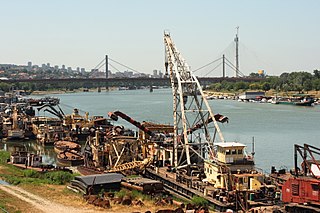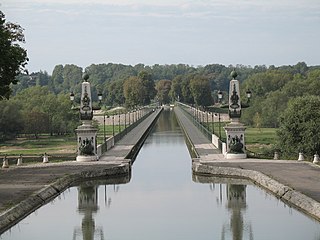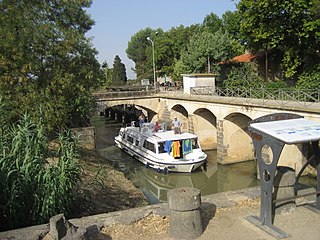
A sailboat or sailing boat is a boat propelled partly or entirely by sails and is smaller than a sailing ship. Distinctions in what constitutes a sailing boat and ship vary by region and maritime culture.

A riverboat is a watercraft designed for inland navigation on lakes, rivers, and artificial waterways. They are generally equipped and outfitted as work boats in one of the carrying trades, for freight or people transport, including luxury units constructed for entertainment enterprises, such as lake or harbour tour boats. As larger water craft, virtually all riverboats are especially designed and constructed, or alternatively, constructed with special-purpose features that optimize them as riverine or lake service craft, for instance, dredgers, survey boats, fisheries management craft, fireboats and law enforcement patrol craft.

The Lot, originally the Olt, is a river in France. It is a right-bank tributary of the Garonne. It rises in the Cévennes mountains, flowing west through Quercy, where it flows into the Garonne near Aiguillon, a total distance of 485 kilometres (301 mi). It gives its name to the départements of Lot and Lot-et-Garonne.
Porto Heli is a summer resort town in the municipality of Ermionida in the southeastern part of Argolis, Greece. It is situated on a bay of the Argolic Gulf, 6 km south of Kranidi and 40 km southeast of Nafplio. The island of Spetses is located 6 km south of Porto Heli. There are ferry connections from Porto Heli to the islands of Spetses, Hydra and Poros, and to Ermioni and Piraeus. There was a small private airport, Porto Cheli Airport, south of the town, but it's closed since 2004 and now the land was sold.

The Briare Canal is one of the oldest canals in France. Its construction started in 1604. It was the first summit level canal in Europe that was built using pound locks, connecting the Rhone-Saône and Seine valleys. It is 57 kilometres long and is part of the Bourbonnais route from Saint-Mammès on the Seine to Chalon-sur-Saône on the Saône.

Bernard Moitessier was a French sailor, most notable for his participation in the 1968 Sunday Times Golden Globe Race, the first non-stop, singlehanded, round the world yacht race. With the fastest circumnavigation time towards the end of the race, Moitessier was the likely winner for the fastest voyage, but he elected to continue on to Tahiti and not return to the start line in England, rejecting the idea of the commercialization of long distance sailing. He was a French national born and raised in Vietnam, then part of French Indochina.

Saint-Valery-sur-Somme, commune in the Somme department, is a seaport and resort on the south bank of the River Somme estuary. The town's medieval character and ramparts, its Gothic church and long waterside boardwalk, make it a popular tourist destination.
The Perkins 4.236 is a diesel engine manufactured by Perkins Engines. First produced in 1964,over 70,000 were produced in the first three years, and production increased to 60,000 units per annum. The engine was both innovative and reliable, becoming a worldwide sales success over several decades.

The Briare Aqueduct in central France carries the Canal latéral à la Loire over the river Loire on its journey to the Seine. It replaced a river-level crossing from the canal to meet the Briare Canal that was hazardous in times of flood. Between 1896 and 2003 it was the longest navigable aqueduct in the world, until the opening of the Magdeburg Water Bridge.

A Dutch barge is a traditional flat-bottomed shoal-draught barge, originally used to carry cargo in the shallow Zuyder Zee and the waterways of Netherlands. There are very many types of Dutch barge, with characteristics determined by regional conditions and traditions.

Nahlin is a luxury yacht and one of the last of three large steam yachts constructed in the UK. She was built for Lady Yule, film financier and horse breeder, and was launched in 1930. She is owned by British industrial entrepreneur Sir James Dyson, who purchased her from Lord Bamford, Chairman of JCB. The name Nahlin is taken from a Native American word meaning "fleet of foot" and the yacht has a figurehead depicting a Native American wearing a feathered headdress beneath the bowsprit.
A sailing barge is a kind of barge propelled by sails. Traditional types of sailing barges include:
A sailing boat that is carrying too much sail for the current wind conditions is said to be over-canvassed. An over-canvassed boat, whether a dinghy, a yacht or a sailing ship, is difficult to steer and control and tends to heel or roll too much. If the wind continues to rise, an over-canvassed sailing boat will become dangerous and ultimately gear may break or it may round-up into the wind, broach or capsize. Any of these eventualities puts the safety of the crew and the vessel in danger. To over-canvass a sailing boat is considered unseamanlike and imprudent. In order to reduce sail, individual sails may be lowered or furled and existing sails may be reefed. Counter-intuitively, many boats will sail faster, and certainly more smoothly, comfortably and safely, when carrying the correct amount of sail in a strong wind than they would if over-canvassed and excessively rolling, heeling, carrying too much weather helm or repeatedly rounding up.

Ouvrages du Libron is a structure like no other on the Canal du Midi. It allows the Libron River, near Agde in south-west France, to traverse the Canal du Midi. At the point of intersection, the Libron is more or less at the same level as the Canal du Midi so a traditional aqueduct was not an option. The problem was further exacerbated by the Libron's propensity to flash flood up to twenty times a year. The problem was originally solved by the building of a pontoon aqueduct known as the Libron Raft which utilised a flush-decked barge to protect the canal channel in times of flooding. However, this was replaced by the present structure in 1855.

Adlard Coles Nautical is a nautical publisher, with over 300 books in print. The company publishes books on topics of interest to sailors and motorboaters and also ‘landlubbers’ with an interest in the sea. Their list includes almanacs, cruising guides, pilot books and how-to instruction books, as well as large format photographic books, sailing narratives and sea-related reference, maritime history, humour and trivia books.
Tom Cunliffe is a British yachting journalist, author and broadcaster.
Jimmy Cornell is a Romanian-born British yachtsman, bestselling author of World Cruising Routes, among other books and the founder of the World Cruising Club.

DBA - The Barge Association is a club for leisure users of European inland waterways. The club was formed in 1992 as "The Dutch Barge Association", by a small group of UK owners of Dutch barges. It later expanded to include any form of barge and other types of boat with the same interests in cruising in European rivers and canals, becoming "DBA - The Barge Association". It is still generally known as "DBA". The DBA publishes a bi-monthly magazine, Blue Flag, plus a more frequent online newsletter.
A wing engine is a subsidiary engine installed in a motor boat alongside the main engine. The primary purpose of a wing engine is to provide redundancy and safety in the event of failure of the main engine; a secondary benefit assists manoeuvering in port or in a marina.















